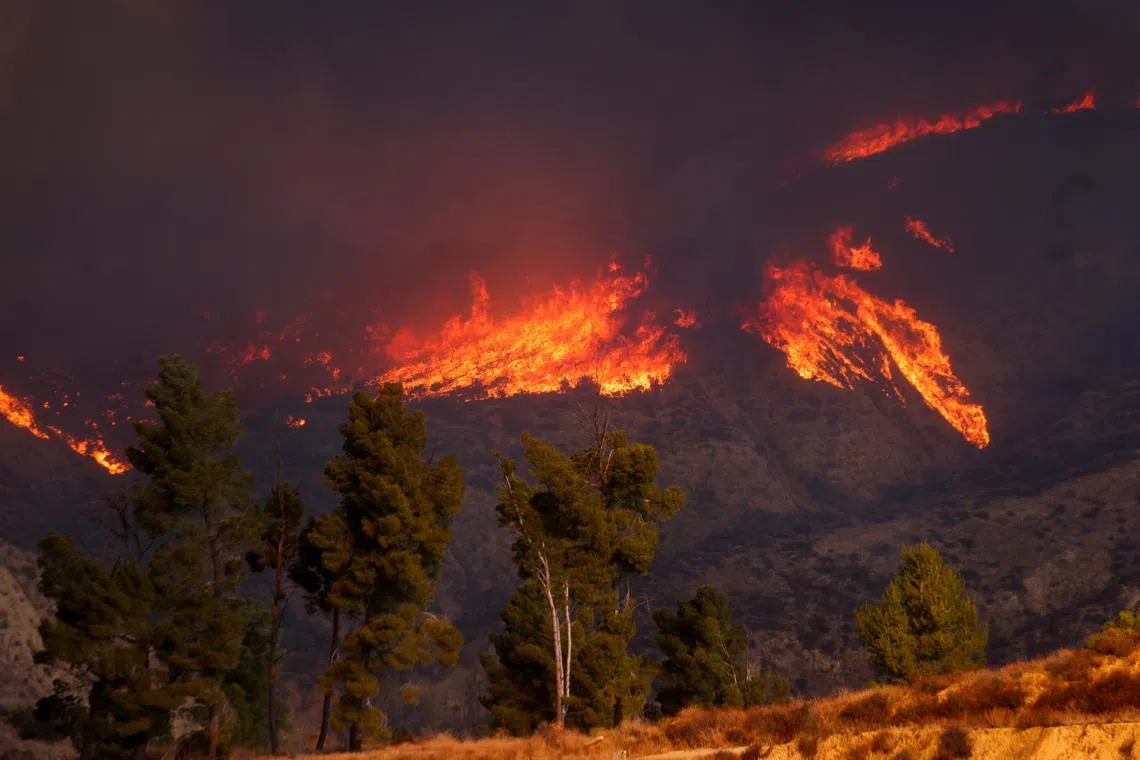Mass evacuations after explosive new fire erupts near Los Angeles
Sign up now: Get ST's newsletters delivered to your inbox

Smoke and flames rise as firefighters and aircraft battle the Hughes Fire near Castaic Lake, north of Santa Clarita, California, on Jan 22.
PHOTO: REUTERS
Follow topic:
LOS ANGELES - A new wildfire erupted north of Los Angeles on Jan 22, exploding in size and sparking evacuation orders in a region already on edge after two deadly blazes
Ferocious flames were devouring hillsides near Castaic Lake, spreading rapidly to cover more than 3,800ha in just a few hours.
The fire was being fanned by strong, dry Santa Ana winds that were racing through the area, pushing a vast pall of smoke and embers ahead of the flames – sparking fears that it could spread further.
Evacuations were ordered for 31,000 people around the lake, which sits around 56km north of Los Angeles, and close to the city of Santa Clarita.
“I’m just praying that our house doesn’t burn down,” one man told broadcaster KTLA, as he packed his car.
The Hughes fire came with the greater Los Angeles area still suffering after two enormous fires that killed more than two dozen people and wreaked billions of dollars of devastation.
As California faces a massive rebuild, President Donald Trump repeated his false claim that the state was improperly diverting water away from the site of the emergency, threatening to withhold federal funds as a result.
“I don’t think we should give California anything until they let water flow down into their system” from the north of the state, Mr Trump said in an interview on Fox News aired on the evening of Jan 22.
Los Angeles’s water supplies are mainly fed via aqueducts and canals originating from entirely separate river basins farther east.
‘Dynamic’ situation
Around 4,000 firefighting personnel, backed up by aircraft and bulldozers, surged to the new blaze, a massive response that Los Angeles County fire chief Anthony Marrone said was paying dividends.
“The situation remains dynamic, and the fire remains a difficult one to contain, although we are getting the upper hand,” he told an evening press conference.
“We are going to be on scene all night long, gaining more perimeter control, making sure that we can put out the hot spots, and then have enough resources and staging so that if we do have a flare-up, we can move those resources to the fire line.”
The hopeful tone came after a nervous day for the region, where many people remained glued to television coverage of the aerial firefight – scenes that became common during lengthy battles to contain the Eaton and Palisades fires.
Helicopters dropped water and planes dumped tens of thousands of gallons of fire retardant, laying down lines of red intended to corral the flames and pinch the fire front.
That fleet included two Super Scoopers – enormous amphibious planes that can carry thousands of litres of water – as well as DC-10 jets and dual rotor helicopters.
Crews from Los Angeles County Fire Department and Angeles National Forest were also attacking the blaze from the ground.
Los Angeles County Sheriff Robert Luna said the Pitchess Detention Centre in Castaic was under an evacuation order, and about 500 inmates had been moved to a neighbouring facility.
Around 4,600 inmates held at other jails in the area were sheltering in place, but buses were on hand in case conditions changed and they needed to be moved, he said.
California Highway Patrol shuttered the I5 motorway for several hours, severing a major artery that runs the length of the US west coast. It reopened during rush hour, but had bumper-to-bumper traffic, as thousands of drivers inched home.
Cal Fire’s Brent Pascua said conditions had come together to make the fire especially volatile.
“We’re getting the winds, we’re getting the low humidities, and this brush hasn’t seen any moisture in so long,” he said. “That all combined together is just making this fire spread extremely fast.”
Winds were expected to continue overnight and into Jan 23.
Human activity, including the unchecked burning of fossil fuels, is changing earth’s climate, increasing average global temperatures and altering weather patterns.
Even though January is the middle of the region’s rainy season, Southern California has not seen any significant precipitation in around eight months, leaving the countryside tinder-dry. AFP

